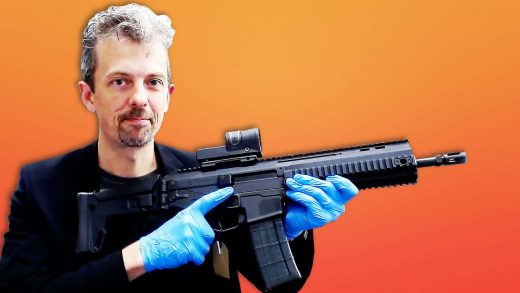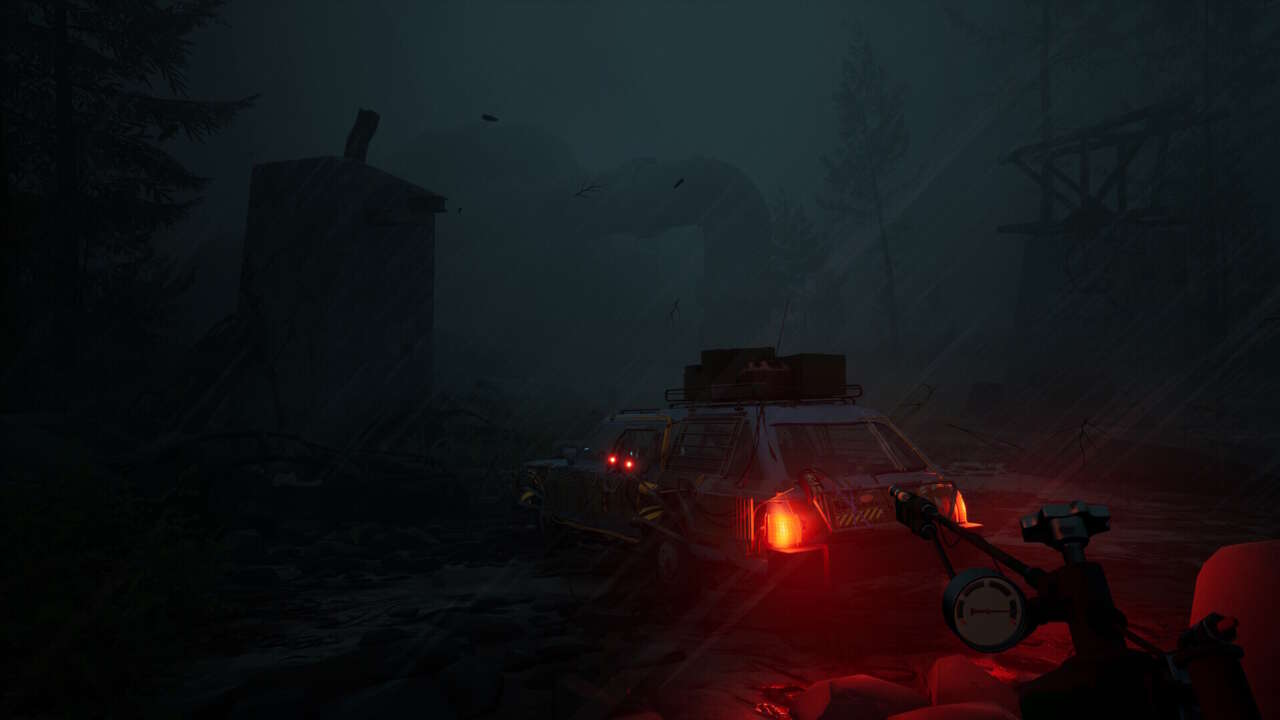
I’m not very far into the Olympic Exclusion Zone in a run of Pacific Drive when the rain picks up. A T-shaped intersection looms just ahead, and as I make a right turn, the headlights play over the wreckage of a truck at the base of a hill, surrounded by trees. I bring the station wagon to a stop but leave it running and hop out, hustling over to the rusting hulk. Trucks are great finds, almost always full of junk I can use to upgrade my car or the garage that acts as my base of operations, and thus, always worth checking.
As I’m rifling through the menu that shows everything found within the truck, I hear it–some kind of high-pitched, siren-like sound coming from the woods behind me–and I freeze. My shoulders are tight and after a few seconds, I start to frantically check the area around me. Despite the hours I’ve spent driving around in the woods, the sound is like nothing I’ve ever heard in the Zone, or maybe anywhere. It has a distinctly mechanical, industrial tenor, something that sounds vaguely generated by a machine, but nothing about its oscillations or tone suggests what possible useful function a machine might undertake that’d generate such a noise. It feels…off. And it sounds like it’s coming from just on the other side of the hill. Whatever is making that sound is somewhere in the woods, out of sight. But it is, distinctly, not far away.

I stand and listen, with rain falling all around me and only the headlights of the car illuminating the thin swathe of green between me and the road, for 10 or 15 seconds. The sound dies out and doesn’t repeat. I wait, and wait, but at last…nothing happens.
Slowly, I finish up with the truck and make my way back to the station wagon, still a little anxious, waiting for something to happen right up until I drive away. Raindrops patter on the windshield, the trees march along on either side of the car, and the headlights cut a path down the lonely overgrown highway. I’ll play tens of additional hours of Pacific Drive from this point, and even looking back now, I can’t say for certain that I’ll ever hear that particular sound again. It doesn’t change, however, how uneasy I feel when I step out of the car–every time I step out of the car.
In fact, Pacific Drive is incredibly good at making you feel uneasy, in a way that takes it beyond most survival games and borders on horror. That’s how I see it, anyway: Across 30 hours, I routinely found wandering around its world to be uncanny and foreboding.
“I think ‘horror’ is definitely not a word that I would have associated with it, but I think ‘scary’ and ‘intense’ definitely came to mind,” Alex Dracott, creative director and founder of developer Ironwood Studios, told me during an interview. “One of the things for me was really trying to capture that very eerie mood of being out alone in the woods in a car, and then you start adding really anything to that, whether it is a thing that goes bump in the night or something that is actually tracking you down around the Zone, it changes very fast.”
Weird woods
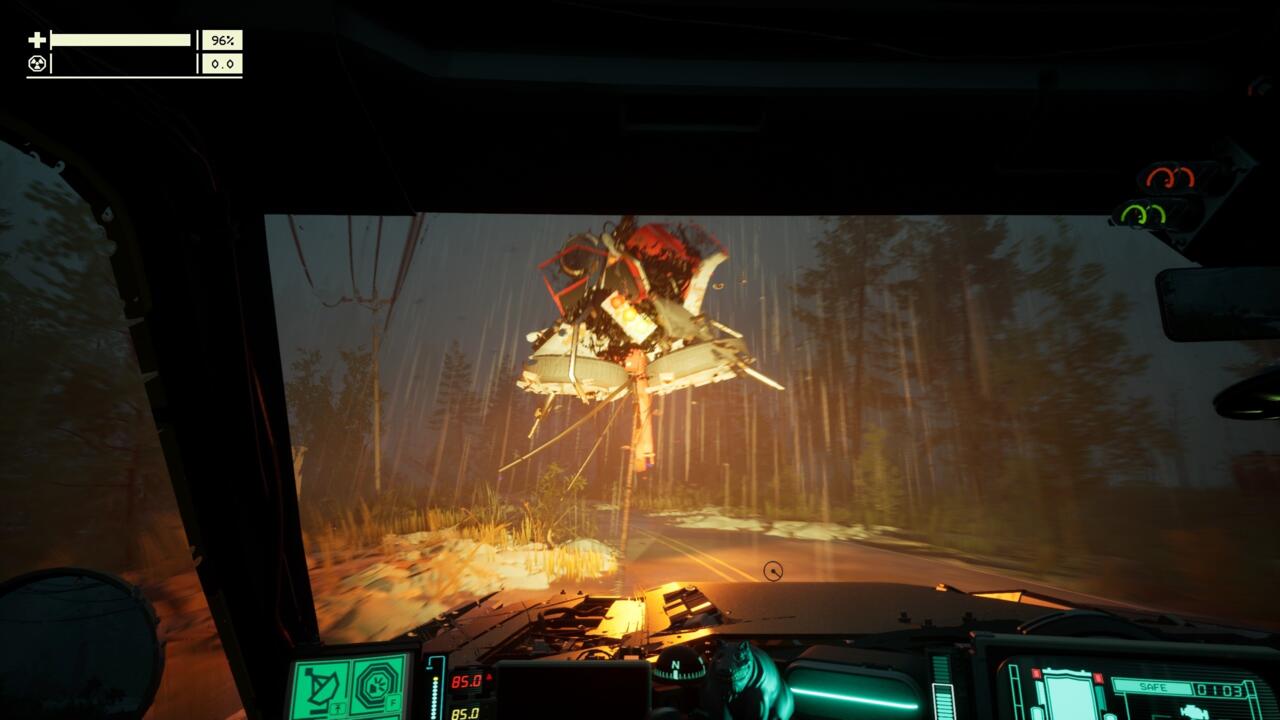
Pacific Drive takes inspiration from the novel Roadside Picnic by Arkady and Boris Strugatsky, its movie adaptation Stalker, and the S.T.A.L.K.E.R. games they inspired, as well as Jeff VanderMeer’s Southern Reach series and its movie adaptation, Annihilation. It’s set in the Olympic Exclusion Zone, a strange, fictional patch of the Pacific Northwest that was the site of government experiments that have fundamentally altered the laws of reality.
Authorities have since sealed off the whole area with monolithic concrete walls hundreds of feet high. Within, the Zone is populated by dangerous “anomalies” that are often hard to describe. Some are inanimate objects that come to life, like round balls of metal called bunnies that roll and hop around to try to stick to your car, or crash test dummies called tourists that might move when you’re not looking at them. Others are trees made of speakers that heal your car with soothing sounds, or colorful wind currents that scramble your driving controls.
Fundamentally, the game is about driving, with its survival elements abstracted from the usual requirements of keeping yourself fed and rested, and focused instead on maintaining your car. Trapped behind the wall, you drive out into the Zone in search of the materials you need, but linger in one place too long, and the physical world might rewrite itself around you–and rewrite you along with it.
For Dracott, the spooky feel of Pacific Drive is somewhat subjective. He drew on fond memories and experiences in the woods of Oregon and Washington in developing the game; wandering through the woods doesn’t scare him. On the other hand, he said, he’s terrified of water. One man’s source of constant dread is another’s pleasant ramble in their familiar station wagon.
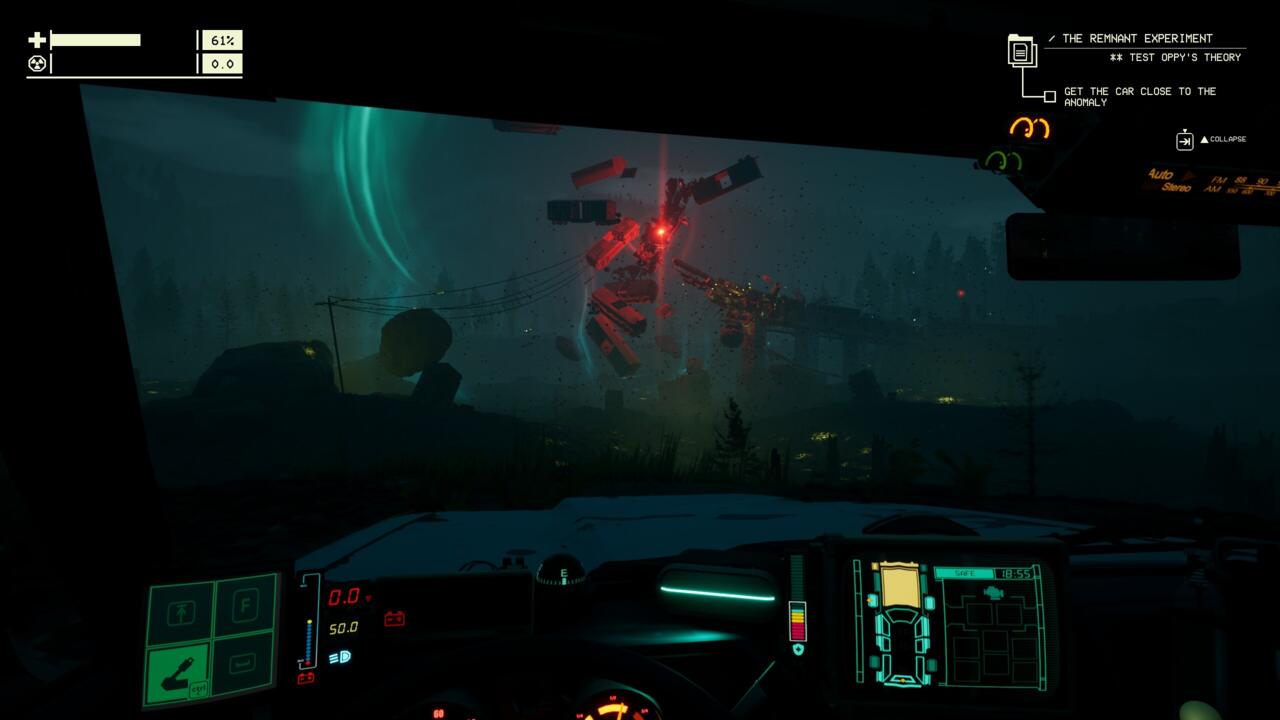
That said, just because they might not consider what they made to be horror, it doesn’t mean the creators of Pacific Drive weren’t deliberately trying to unnerve.
“Tension was an important thing, right? We definitely were very aware early on of the kind of atmosphere that we were making,” Dracott continued. “It became a question to think of how much are we going to then, for lack of better words, ‘jump’ the player and lean into it, which we did in moments, without a doubt.”
Pacific Drive might not be a horror game in the usual sense, but it can tap into some of the same feelings, game director and lead designer Seth Rosen said, especially since the Olympic Exclusion Zone is meant to be a place that’s so much at odds with the world as we know it.
“We wanted it to be sort of a menacing environment, but not necessarily one of out-and-out horror,” Rosen explained. “You should feel like you’re under threat and that there are things you don’t understand that kind of build that feeling of being in danger, and that’s where a lot of our particular brand of ‘horror’ comes from I think. We weren’t, you know, trying to create a game where blood [is] dripping down the walls and all these kinds of full-blown horror experiences. But you can elicit a lot of the same emotions just through keeping the player on their toes and getting them and keeping them into this sort of mental state where they don’t necessarily feel like they can trust their senses.”
Bumps in the night
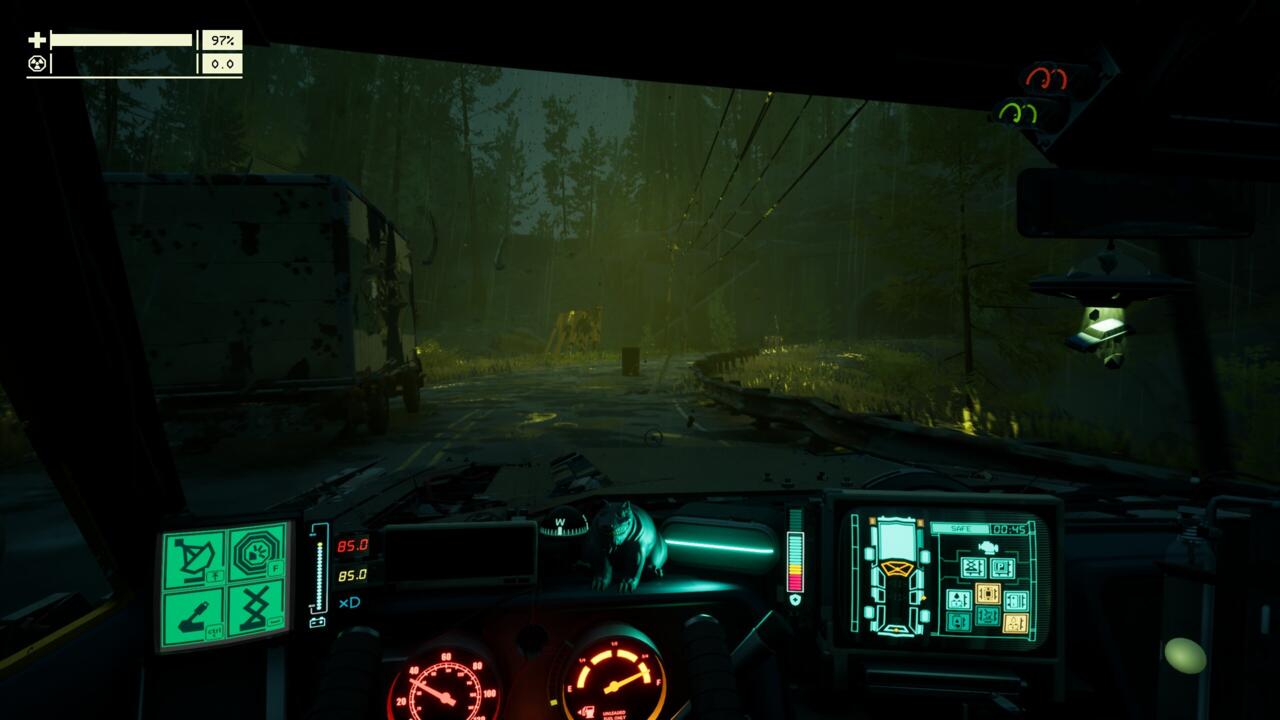
The reality of playing Pacific Drive is that developer Ironwood Studios might have done too good a job at making its setting feel almost upsettingly strange. A lot of that feeling comes down to sound design, which is consistently excellent throughout the game. Much of what makes the anomalies feel otherworldly is the way they sound.
Em Halberstadt, creative director for game sound design studio A Shell in the Pit who was responsible for Pacific Drive’s audio direction, explained that the sound approach for the anomalies was inspired by how each one looks, mixing the use of real materials–the crackle of electricity for the charged mists or arc-firing towers, goopy hisses for acid-based threats–with more unsettling elements. For the bunny anomaly–the aforementioned fast-moving ball of metal–the sound design was determined by the need to convey the immediacy of the threat the anomaly posed.
“When we were designing the anomalies, we were really thinking about how dangerous each one is, and adding in techniques we use to make you uncomfortable the more dangerous something is, so that you’ll not want to hang around it,” said Halberstadt. “Like higher frequencies make us a little bit more uneasy. So for example, the bunnies, when they come leaping at you, that’s one of the more aggressive moments and it’s a really high-pitched shriek, which is also human voice, which is another thing that we use that unsettles you–a lot of the ambiences and anomalies use human voices, which is kind of just naturally creepy.”
There are also a lot of happy accidents that seem to have come together to give Pacific Drive its specific feel. For one, as Rosen explained, because the main way you interact with dangers is to drive around or away from them, anomalies needed to be designed so that they were both quickly legible and navigable at a distance, before you drive up on them. That meant the sounds attached to anomalies can be heard at fairly long distances, Halberstadt said.
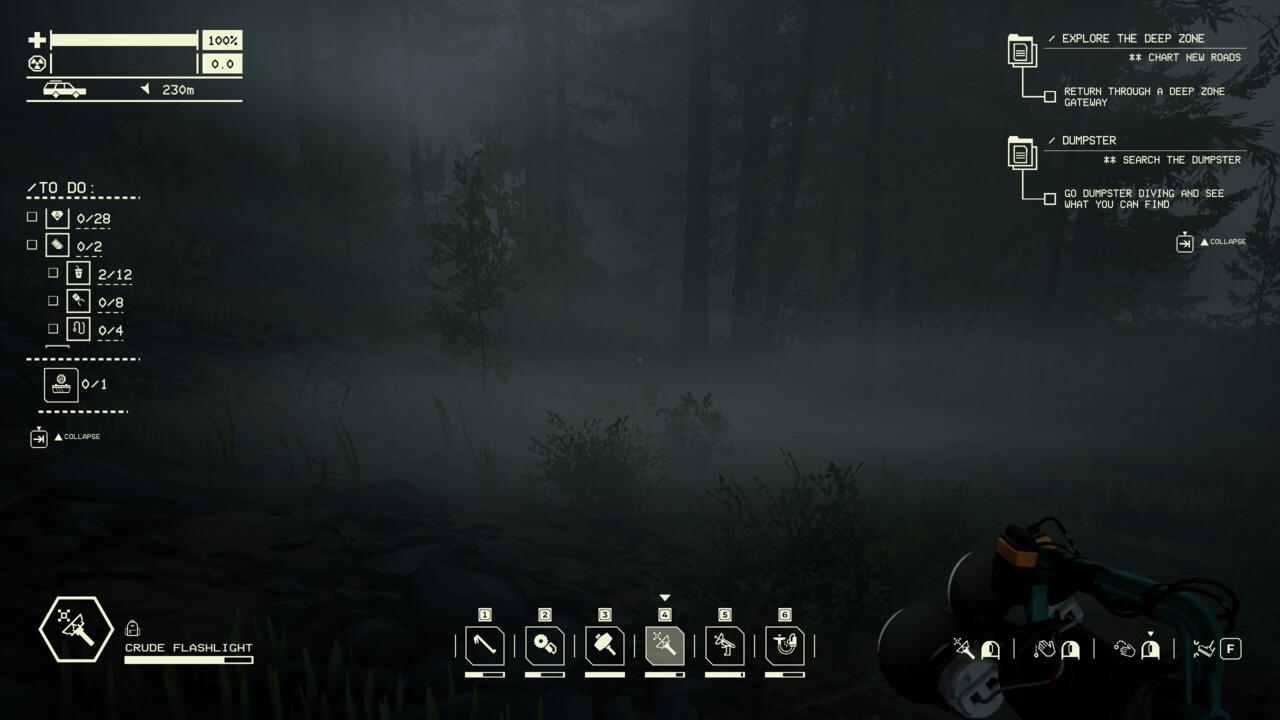
One of the consequences of those design choices, however, is that when you’re out of your car, running to loot a house or scavenge some metal, you might hear anomalies that you don’t see. And while the sounds of each anomaly are specific and meant to convey how much danger they put you in, I found that hearing them out of context often left me confused and disoriented. That soundscape adds to the tension and the strangeness and vulnerability you feel every time you’re out of the car.
The car, too, can add to the uncanniness of the situation. Pacific Drive is designed so that the car is central to the experience. You move around the game from a first-person perspective, but the car is your home, your safety, and your companion. Halberstadt said the team worked to convey that feeling through sound design by reducing elements like the pitch of sounds or their intensity when you’re in the car. But that feeling of safety in the car is contrasted with one of menace when you step outside of it, and all the decisions that make being in the car feel safer make the outside world feel all the creepier.
The spookiness of the sound design isn’t nearly as incidental as some of these design elements might make it appear. There’s also that strange siren I heard out in the woods, the one unsettling enough that it got under my skin. That sound, the team explained, is not actually tied to a specific threat–it, and other sounds like it, exist specifically to add to the game’s unnatural atmosphere. Dracott said that senior sound designer Egan Budd, who worked on the sounds, specifically worked to choose elements that wouldn’t be easily identifiable. The team also chose not to make those sounds part of the ambient background, but to give them specific positions, to make it seem like something is creating them.
“The contrast between the natural world is why they work so well,” Halberstadt said. “Having them be buzzing and metallic, and all of these weird materials that don’t belong in a forest, I think really adds to the unsettling and spooky atmosphere. And I think the randomness as well. The fact that we set different ones to appear at different times in different spaces in the Zone, different levels so you never really know–there’s no pattern at all to them. And I think that you really want there to be a pattern. You’re trying to connect them, but it just doesn’t connect to anything, and something in our brain doesn’t like that. Just having them be something you can’t really explain, because that’s kind of what the Zone is.”
Spooky–but not scary
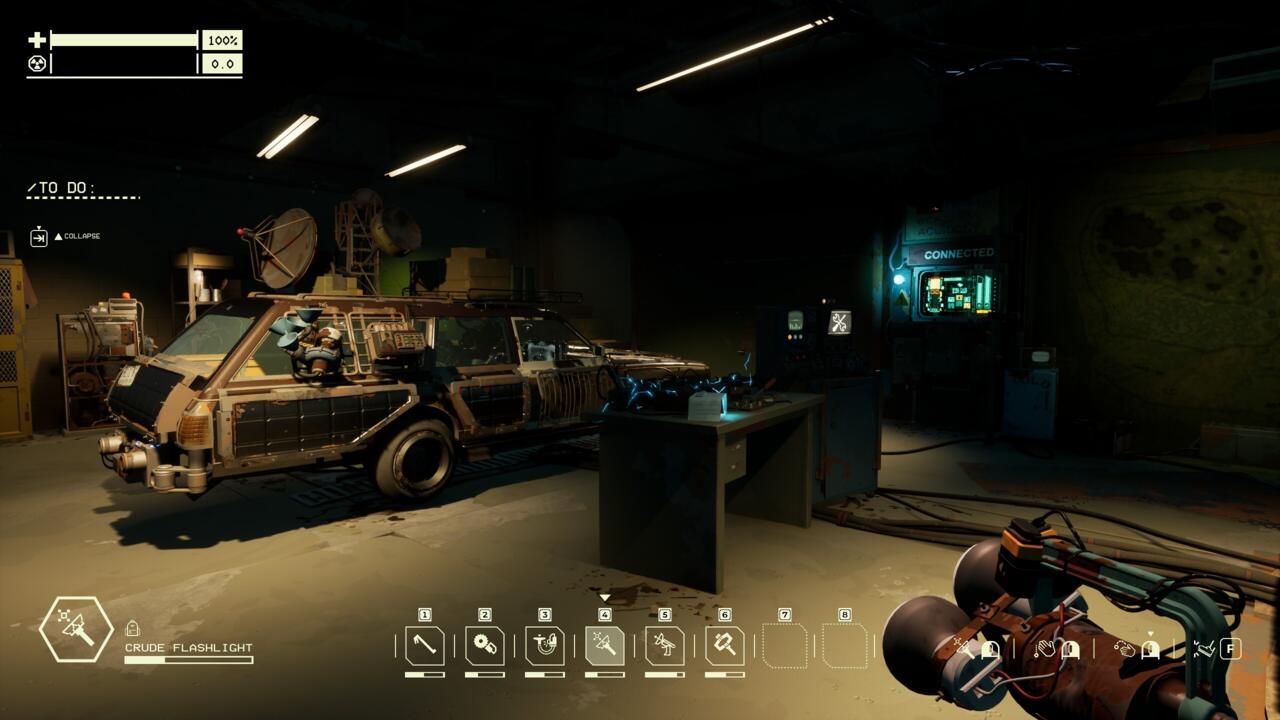
If Pacific Drive does have elements of a horror game, it’s one that’s spooky without being scary. The anomalies, which range from unexplained fields of electric mist to heaps of metal inexplicably brought to life, don’t function like the deadly monsters of a horror game. Instead, they’re more like animals. Some might try to drag off your car for a second or two, or abscond with a headlight or a door, and while a few can hurt you, they often act more like obstacles than predators. But it’s clear throughout Pacific Drive that you’re never in the same kind of danger you might be in other games. Though those frightening sounds in the distance made the hairs on my neck stand up, I knew that no vicious creature would come tearing out of the woods at me, bearing teeth and claws.
It results in what almost might be called a relaxed or chill approach to horror–a pervasive sense of being creeped out by an unnatural and sometimes even dangerous place, without an accompanying, oppressive sense of an actual threat.
Pacific Drive conveys that more relaxed tone in a number of ways. The game’s narrative is largely conveyed by scientists who’ve stayed behind in the Zone to study it after the government evacuated years earlier, who give a lot of the proceedings a comedic tone. The small cast is never especially perturbed by the lethality of the Zone, even as they sometimes send you to do things like launch your car off a bridge in the name of an experiment.
You can also tune your car’s radio to play music from the game’s soundtrack of relatively folksy, chill tunes, playing up the “drive through the woods” feel while undercutting the “impossible realm that defies the laws of nature” aspect.
As you progress in your exploration of the Zone, you can unlock highway stretches that serve as shortcuts to travel longer distances with fewer stops, and which serve to provide something of a more relaxed, less dangerous opportunity to just drive. Between trips, you go back to your garage, an eminently safe place, to maintain and upgrade your car, and the fantasy of being a mechanic working on a vehicle you’re highly familiar with is a big part of the game experience. The garage even contains an anomaly of its own–a friendly Dumpster that will spit out crafting components, often anticipating whatever it is you need but don’t have for your current project.
“This is something that’s really important to me, being able to give people that feeling of relief, because I do think that, especially, sound can be very overwhelming sometimes,” Halberstadt said. “So it’s just, for me, really about being super conscious about it and not only designing with that in mind, so like making sure it doesn’t kind of like trigger any, like, pain tendencies when you’re hearing it, but to play the game a lot and just pay attention to how I’m feeling and, like, lowering volumes quite a lot when they’re too intense.”
As Rosen noted, even the most “dangerous” anomalies mostly ignore you, and because the game’s focus is on driving, all the anomaly designs had to be somewhat restrained so that players could understand and avoid them while driving. Dracott also mentioned that a key part of the survival game feel is the “poke it with a stick” approach to gameplay, to make sure players were able to learn about the world around them without being too freaked out by it.
Still, the fact that the Zone is largely indifferent to the player can, again, play into the sense that it’s unnatural, especially as so much of what populates the Zone is life made up of the trash and machinery added to it by the humans who were studying it.
“I think the fact that the zone is sort of indifferent to you, it’s an ecology that is a dangerous ecology to exist in, is part of that sort of simmering aspect of the ‘horror,’ where … we don’t have much that is focused on you and aggressive towards you. If you kind of stray into its domain and then it’ll take notice and feel some kind of way in a lot of cases. But there’s this kind of aspect of if you leave it well enough alone, then it’ll leave you alone, which makes it all feel really precarious.”
Drive for your life
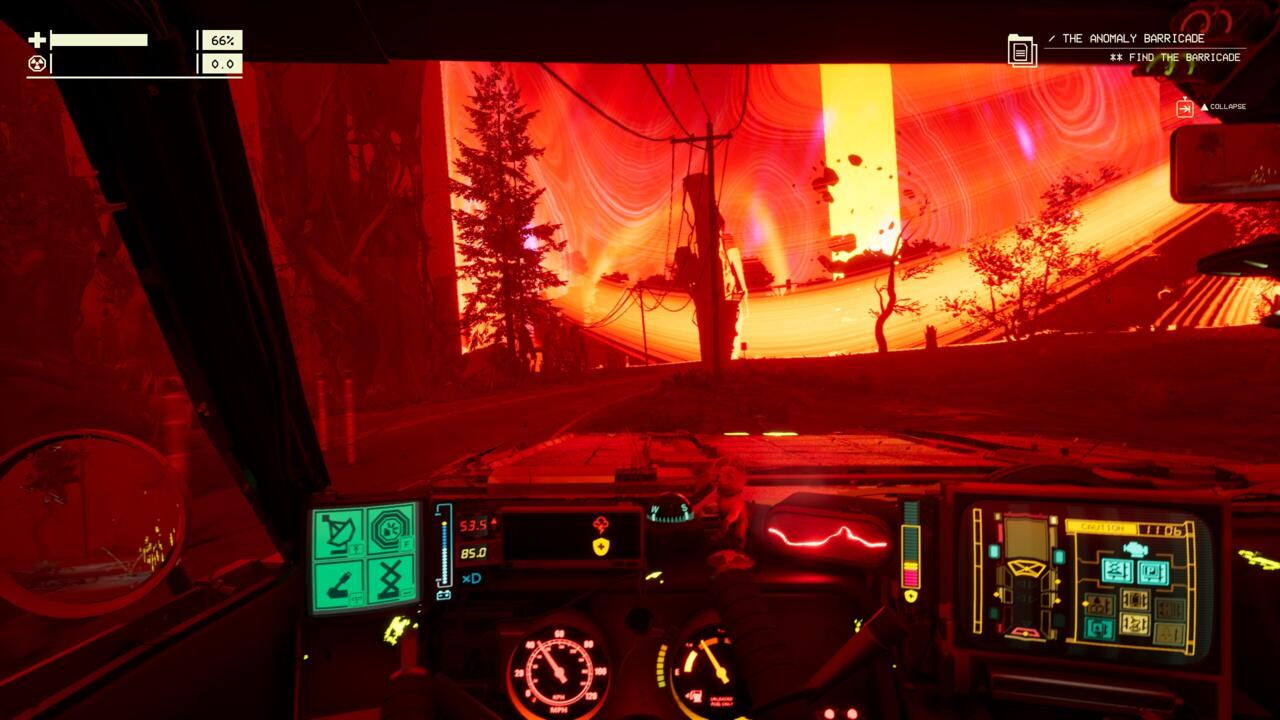
Not all of Pacific Drive is ambient tension and creepy but ultimately underplayed threats. Sometimes, things get legitimately death-defying.
Whenever you go out on a run into the Zone, it’s a one-way trip. Eventually, if you hang around an area too long, a siren will sound, warning you of rising instability in the area. This takes the shape of a storm that’s not unlike the collapsing circle of a battle royale game, forcing you to vacate the area or risk a slow, irradiated death that even your car can’t save you from.
Escaping back to the garage isn’t a drive back the way you came, but instead a head-long charge into a huge column of overwhelming orange light that teleports you home instantly. You can activate that column once you’ve scrounged up enough special energy objects from around the Zone, but you have to be a certain distance away, and doing so immediately triggers the storm–meaning that every escape becomes a high-speed chase.
A weather anomaly in the deepest parts of the Zone is called a meteor shower, but that doesn’t do it justice by any stretch. The “meteors” that fall are not small rocks but rectangular slabs of stone, more akin to double-wide trailers, slamming into the ground ahead of you to form a concrete city of death as you’re driving through it.
All that to say that Pacific Drive can get your heart pumping with more than spooky sounds and the occasional mannequin standing right behind you when you turn around.
“We wanted to make sure that there were some things in the game that sort of dwarfed everything else that you’d seen,” Rosen said of the huge meteors and the colossal scale of things like the storm. “Because it’s pattern recognition, and being able to feel comfortable. And then you have something that sort of transgresses on your current mental model, and you’re like, ‘Okay, whoa, hold on–what else can happen? I’m suddenly worried.'”
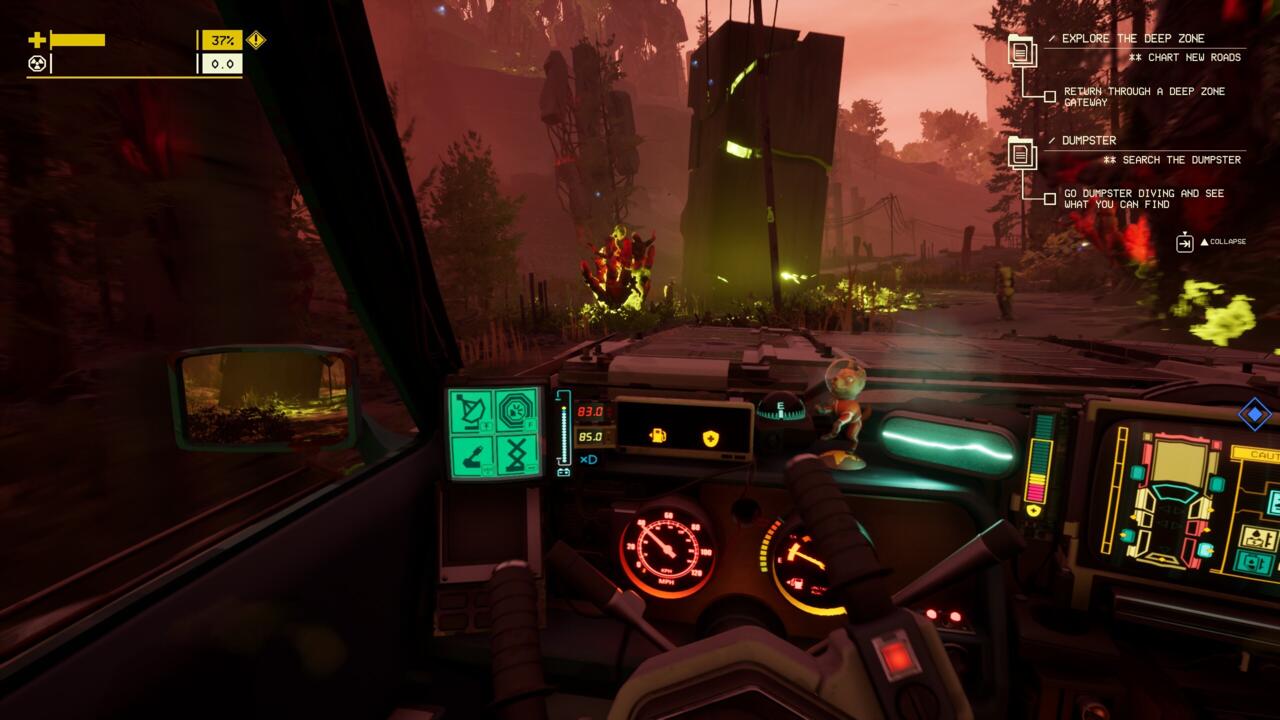
“Just staying aware of all these different things and not knowing what can come crashing out of the sky really elevates that sense that nothing is reliable,” he continued. “And you know, we do all things at all different levels in the game to kind of stave off that pattern recognition as much as we can. Because the more tentative you feel and the more you feel like your plans might need to change at any moment, as they do with these larger gameplay moments, the more effective any other thing that we’re doing to kind of keep you with the hair on the back of your neck standing up is going to be.”
Unnerving possibility
At its heart, this is what makes Pacific Drive work and feel so unique–a game that can do scary and chill in equal measure. The elements Ironwood Studios has put together consistently make it feel like you haven’t seen everything that’s in the Zone, and that nothing you know is really trustworthy. The strange landscapes, the unnatural creatures, the spooky sounds: They all work to upend your sense of the rules of the place in myriad large and small ways. But not every instance of breaking the pattern or upending the rules is a scary or dangerous one.
Driving through the Zone in need of scrap metal to enhance my car’s defenses, I once came upon a whole road full of wrecked cars. But scattered throughout was also a huge crowd of tourists, the crash test dummies that sometimes move when you’re not looking at them. Another important tidbit: Touch, run over, or otherwise smack a tourist, and it will explode, often creating a chain reaction with its brethren.
I parked and carefully walked among the wrecks, trying to keep the tourists in sight as I started using my scrapper, essentially a portable grinder for tearing up metal, on one of the cars. Too late I realized its durability had nearly run out, and this early in the run, I knew I didn’t have the components necessary to make a new one.
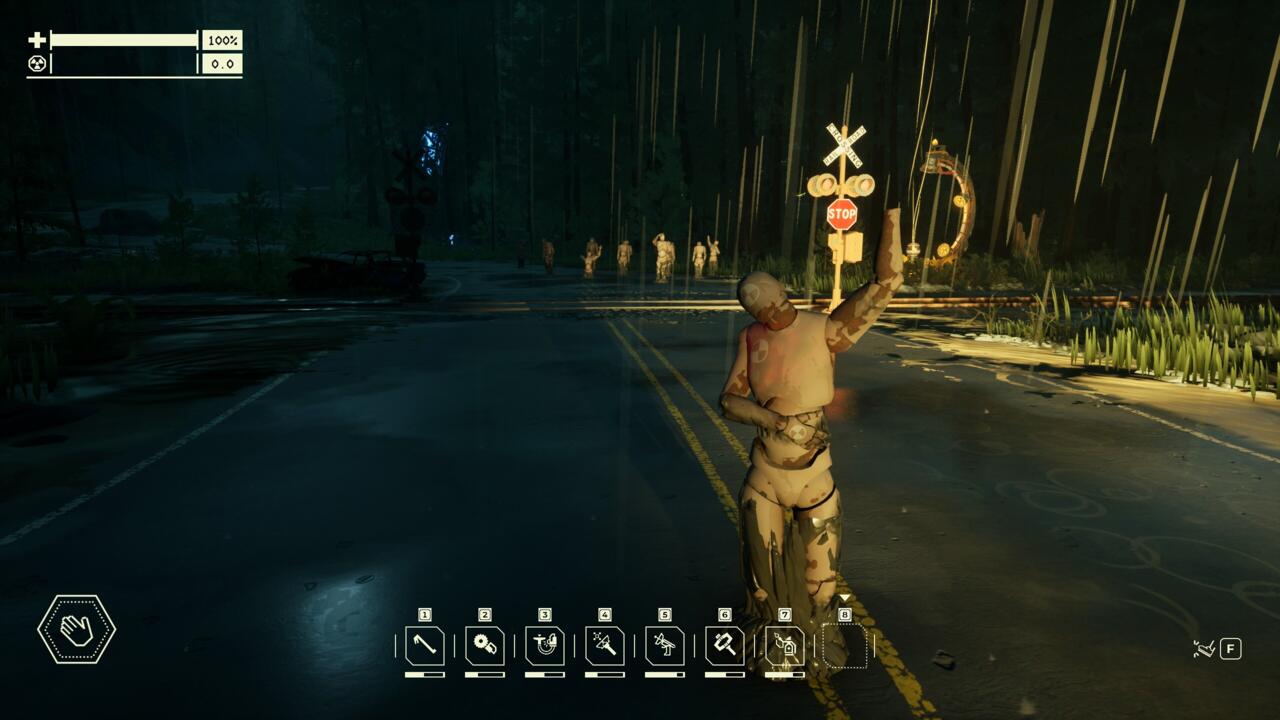
I was digging through my inventory when the sound of something heavy hitting pavement seemed to explode in my headphones, right next to me. I jumped in my seat, slammed the Escape key to get out of the menu, and looked around, expecting to see a horde of frozen statues standing inches away.
Instead, the nearest tourist was still 10 or 15 feet off, but it looked different somehow. I looked down to where I’d heard the sound and saw not a murderous inanimate object, but a fresh scrapper to replace my broken one. The tourist, I slowly realized, had helpfully tossed it to me–something I had no idea they could do.
Rosen noted that, whenever you pop open a car trunk with your handy pry bar, there’s something like a 2% chance that a bunny might pop out for a light jump scare.
“It’s an infrequent enough thing that it remains surprising, and having like a bunch of little things like that, where it kind of subvert your expectations or surprises you in some ways, keeps you in that headspace where you know, obviously, it’s a game, it is a bounded possibility space at some point, but you don’t feel like you ever have a grip on what it is that could happen,” he said. “And therefore, it allows your imagination to really like run wild when you do hear those bumps in the night and those random noises that are kind of surrounding you and contributing to that feeling of, well, you know, I’ve seen this thing once in my 30 hours of play–who’s to say that sound couldn’t be something else new?”

